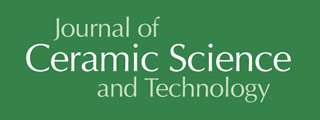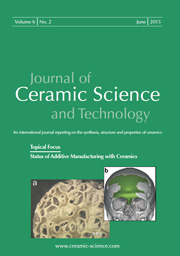Articles
All articles | Recent articles
Influence of Meso-Scale Material Properties on Macro-Mechanical Behavior of Three-Dimensional Four-Directional Braided Composites under Uniaxial Tensile Load
J. Xin, Z. Fang, S. Yasong
School of Power and Energy, Northwestern Polytechnical University, Xi'an 710072, China
received August 26, 2021, received in revised form July 5, 2022, accepted July 5, 2022
Vol. 13, No. 2, Pages 83-98 DOI: 10.4416/JCST2021-00017
Abstract
Herein, a novel non-linear finite element model (FEM) is presented to investigate the influence of meso-scale material properties on the uniaxial tensile behavior of three-dimensional, four-directional braided composites. A reconstructed representative volume element (RVE) model is first introduced based on the micro-computed tomography (µ-CT) data and several damage modes, representing damage of yarns, matrix and the yarn/yarn and yarn/matrix interfaces, are taken into account in the meso-scale FEM model. The simulated mechanical behaviors and damage evolutions under longitudinal, transverse and off-axis tension were presented and analyzed. Furthermore, a numerical parametric study is conducted to evaluate the influence of several key meso-scale material properties on the macro stress-strain relationship and ultimate strength. The preliminary results reveal that, under longitudinal tensile load, the shear strength renders a more significant effect than the interface properties on longitudinal tensile strength because the shear stress decreases the longitudinal load capacity of yarns, however, the interface debonding only alters the complex stress state. On the other hand, under transverse tensile load, the yarn transverse direction and interface are the main load transfer routes. Thus, the transverse damage of yarns and interface damage coexist and compete, where the weaker one determines the transverse strength. The current work presents an efficient strategy to improve the performance of composites under a specific load. Also, it indicates that further work is required to obtain more accurate meso-scale material parameters.
![]() Download Full Article (PDF)
Download Full Article (PDF)
Keywords
Four-directional braided composites, ceramic matrix composites, damage models, failure mechanism, meso-scale material properties
References
1 DiCarlo, J.A., Roode, M.V.: Ceramic composite development for gas turbine engine hot section components. In: ASME Turbo Expo 2006, Power of Land, Sea and Air, 2006.
2 Pluvinage, P., Parvizi-Majidi, A., Chou T.W.: Damage characterization of two-dimensional woven and three-dimensional braided SiC-SiC composites, J. Mat. Sci., 31, [1], 232 – 241, (1996). DOI: 10.1007/BF00355150.
3 Xin, J., Shi, D.Q., Yang, X.G., Zhao, C.J.: Fiber strength measurement for KD-i(f)/sic composites and correlation to tensile mechanical behavior at room and elevated temperatures, Ceram. Int., 41, [1], 299 – 307, (2015). DOI: 10.1016/j.ceramint.2014.08.072.
4 Lu, S.D., Gao, X.G., Song, Y.D.: Prediction method on equivalent thermal conductivity coefficient of plain braided C/SiC composites material based on finite element method, J. Aerosp. Power, 29, [7], 1574 – 1582, (2014). DOI: 10.13224/j.cnki.jasp.2014.07.009.
5 Shen, X., Liu, X., Dong, S., Gong, L.: RVE model with shape and position defects for predicting mechanical properties of 3D braided CVI-SiCf/SiC composites, Compos. Struct., 195 (JUL.), 325 – 334, (2018). DOI: 10.1016/j.compstruct.2018.04.074
6 Kostar, T.D., Chou, T.W.: Process simulation and fabrication of advanced multi-step three-dimensional braided preforms, J. Mat. Sci., 29, [8], 2159 – 2167, (1994). DOI: 10.1007/BF01154695.
7 Pandey, R., Hahn, H.T.: Visualization of representative volume elements for three dimensional four step braided composites, Compos. Sci. Technol., 56, [2], 161 – 170, (1996). DOI: 10.1016/0266 – 3538(95)00137 – 9.
8 Chen, L., Tao, X.M., Choy, C.L.: On the microstructure of three-dimensional braided preforms, Compos. Sci. Technol., 59, [3], 391 – 404, (1999). DOI: 10.1016/S0266 – 3538(98)00079 – 7.
9 Fang, G.D., Liang J., Yu, W., Wang, B.L.: The effect of yarn distortion on the mechanical properties of 3D four-directional braided composites, Compos. Part A Appl. Sci. Manuf., 40, [4], 343 – 350, (2009). DOI: 10.1016/j.compositesa.2008.12.007.
10 Li, D.S., Li, J.L., Chen, L., Lu, Z.X., Fang, D.N.: Finite element analysis of mechanical properties of 3D four-directional rectangular braided composites part 1: microgeometry and 3d finite element model, Appl. Compos. Mater., 17, [4], 373 – 387, (2010). DOI: 10.1007/s10443 – 010 – 9126 – 2.
11 Goldsmith, M.B., Sankar, B.V., Haftka, R.T., Goldberg, R.K.: Quantifying effects of voids in woven ceramic matrix composites. In: 54th AIAA/ASME/ASCE/AHS/ASC Structures, Structural Dynamics, and Materials Conference, Boston, Massachusetts, 2013. DOI: 10.2514/6.2013 – 1619.
12 Naouar, N., Vidal-Sallé, E., Schneider, J., Maire, E., Boisse, P.: Meso-scale FE analyses of textile composite reinforcement deformation based on X-ray computed tomography, Compos. Struct., 116, [1], 165 – 176, (2014). DOI: 10.1016/j.compstruct.2014.04.026.
13 Straumit, I., Lomov, S.V., Wevers, M.: Quantification of the internal structure and automatic generation of voxel models of textile composites from X-ray computed tomography data, Compos. Part A Appl. Sci. Manuf., 69, 150 – 158, (2015). DOI: 10.1016/j.compositesa.2014.11.016.
14 Evans, A.G., Zok, F.W.: The physics and mechanics of fibre-reinforced brittle matrix composites, J. Mat. Sci., 29, [15], 3857 – 3896, (1994). DOI: 10.1007/BF00355946.
15 Lamon, J.: A micromechanics-based approach to the mechanical behavior of brittle-matrix composites, Compos. Sci. Technol., 61, [15], 2259 – 2272, (2001). DOI: 10.1016/S0266 – 3538(01)00120 – 8.
16 Zhang, D., Hayhurst, D.R.: Prediction of stress-strain and fracture behaviour of an 8-harness satin weave ceramic matrix composite, Int. J. Solids. Struct., 51, [21 – 22], 3762 – 3775, (2014). DOI: 10.1016/j.ijsolstr.2014.07.010.
17 Fagiano, C., Genet, M., Baranger, E., Ladeveze, P.: Computational geometrical and mechanical modeling of woven ceramic composites at the mesoscale, Compos. Struct., 112, [1], 146 – 156, (2014). DOI: 10.1016/j.compstruct.2014.01.045.
18 Lu, Z., Wang, C., Xia, B., Yang, Z.: Effect of interfacial properties on the uniaxial tensile behavior of three-dimensional braided composites. Comp. Mater. Sci., 2013, 79(Complete), 547 – 557, (2013). DOI: 10.1016/j.commatsci.2013.07.017.
19 Fang, G.D., Liang, J., Wang, B.L., Yu, W.: Effect of interface properties on mechanical behavior of 3D four-directional braided composites with large braid angle subjected to uniaxial tension, Appl. Compos. Mater., 18, [5], 449 – 465, (2011). DOI: 10.1007/s10443 – 010 – 9175 – 6.
20 Jing, X., Cheng, Z., Teng, X.F., Yang, X.G., Shi, D.Q.: Reconstruction of meso-structure and numerical simulations of the mechanical behavior of three-dimensional four-directional braided ceramic matrix composites, Ceram. Int., 46, [18], 29309 – 29320, (2020). DOI: 10.1016/j.ceramint.2020.08.107.
21 Kuhn, J.L., Charalambides, P.G.: Elastic response of porous matrix plain weave fabric composites: Part I-Modeling, J. Compos. Mater., 32(16), 1426 – 1471, (1998). DOI: 10.1177/002199839803201601.
22 Hashin, Z.: Failure criteria for unidirectional fiber composites, J. Appl. Mech., 47, [2], 329 – 334, (1980). DOI: 10.1115/1.3157744.
23 Curtin, W.A.: Theory of mechanical properties of ceramic matrix composites, J. Am. Ceram. Soc., 74, [11], 2837 – 2845, (2010). DOI: 10.1111/j.1151 – 2916.1991.tb06852.x.
24 Dassault Systemes SIMULIA Corp: Abaqus Analysis User's Manual Version 6.14, (2014).
25 ASTM D2344/D2344M-16, Standard test method for short-beam strength of polymer matrix composite materials and their laminates, ASTM International, West Conshohocken, PA, 2016.
26 Rajan, V.P., Zok, F.W.: Matrix cracking of fiber-reinforced ceramic composites in shear, J. Mech. Phys. Solids, 73, 3 – 21, (2014). DOI: 10.1016/j.jmps.2014.08.007.
Copyright
Göller Verlag GmbH


